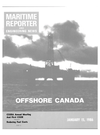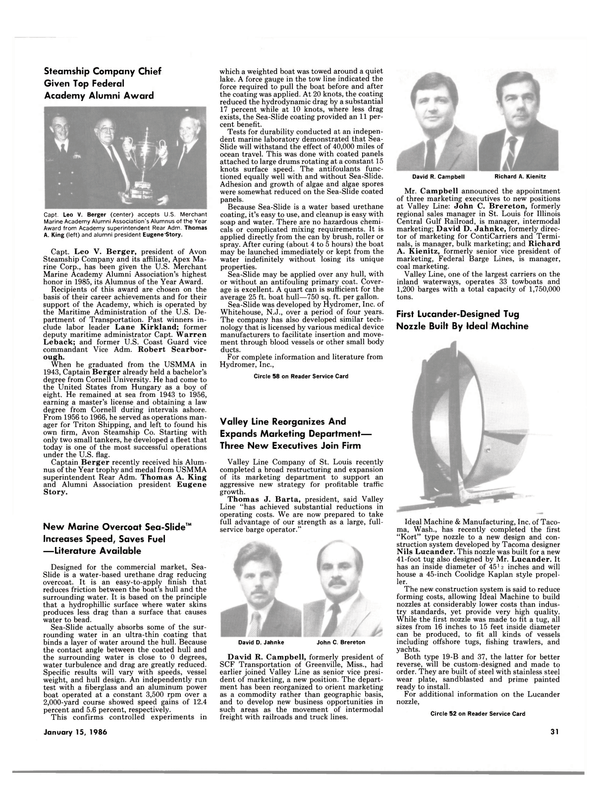
PNOC Marine And Bardex Hydranautics Build World Class Shipyard
The PNOC Marine Corporation facility at Batangas Bay in the Philippines has experienced dramatic and rapid growth during its short five-year life. It has developed into a modern Lloyds-rated Class A shipbuilding and repair complex.
Strategically located on a 50-hectare site at San Miguel, Bauan, Batangas, PNOC successfully competes for business with the world's leading yards. In large measure, its position in the industry is based on an economical, tradition-breaking approach to yard outfitting which allows the yard to offer competitive prices for construction and repair work.
PNOC Marine Corporation (PMC) is a wholly owned subsidiary of the Philippine National Oil Company (PNOC). In 1974, PNOC acquired a shipping transport fleet to secure the movement of petroleum products. A repair and maintenance facility was planned to support the requirements of the fleet. In 1980, the support facility was completed as a fully equipped shipbuilding and repair yard. With its commissioning, the corporation increased the national capacity by nearly 20 percent.
Today, PMC services the domestic shipping fleet as well as foreign requirements.
With its 1,000-plus work force, the yard undertakes construction and repair work (up to 23,000 dwt); dockside repairs of vessels with drafts of up to 40 feet; and engineering works and fabrication of components, modules and prefabricated structures. In total, PMC has constructed ten vessels and handled the repair of over 350 tankers, tug boats and barges since 1981.
When designing the facility, PMC consulted with Bardex Hydranautics of Goleta, California for the most cost-effective yard layout possible.
The result has been an integrated facility that allows maximum scheduling flexibility, easily accessible work areas, and utmost utilization of available space. A two-fold savings was realized in the new yard construction: first, in initial installation costs and, then later, in costs associated with ship repair and maintenance.
The centerpiece of the yard is a hydraulic chain jack shiplift elevator and a hydraulic wheeled transfer system (bogie train) designed and supplied by Bardex Hydranautics.
The lift is Lloyds-rated Class A with a maximum net lift capacity of 12,000 long tons. A total of sixty, 250-long-ton, hydraulic chain jacks lift the 28-meter by 172.5-meter platform in safe synchronized steps of one chain pitch at a time. The chain is a predictable tension member in terms of safety and long life.
Using chain enables precise monitoring of any deterioration from salt water corrosion by simple measuring and visual inspection.
In designing the shiplift system, Bardex Hydranautics took into account the many classes of ships anticipated at the yard. As a result, the platform can accommodate varied load distributions. The platform is lifted or lowered by a single operator at a variable speed depending on the load.
One of the most important features of the yard is the "pitless" wheeled transfer system that operates in concert with the new shiplift system to service eight repair berths and a new construction/erection area having varying capacities up to 23,000-dwt tons.
The bogie train (which can be divided for smaller ships) rolls under the blocked ship in the platform and is hydraulically jacked up to lift the vessel from the platform blocks.
The train then moves the vessel off the platform onto the land rail system.
During this transfer, the lift cylinders serve a dual purpose, that of lifting and load limiting. If an overload occurs on a bogie due to yard variations, the hydraulic-operated cylinder on that bogie will retract to relieve and redistribute the load to the adjacent bogies, thus preventing damage to the wheels, bearings and vessels.
To change the movement from longitudinal to lateral under full load conditions, the bogie train and vessel are lowered onto plinths which are carried by the train. All bogies are rotated for lateral or longitudinal transfer. Under half-load conditions, the change from longitudinal to lateral movement is even easier since half the bogies can be arrayed for lateral and the other half for longitudinal transfer. All that is then required is hydraulic actuation to move the vessel into any one of the nine berths.
The hydraulic bogie system saved on the amount of tract and structural steel required and on wheel costs.
Further, the cost of excavating a traditional side transfer area pit was completely avoided.
The Bardex system provides a hydraulic interface between the ship and the yard level and allows a much higher yard level tolerance.
The hydraulic interface can accommodate tolerances of 2-inches. Allowing yard settlements in this range permits the use of crushed rock with ties for load spreading. In areas of settlement above tolerance, added rock can be worked in and under ties to return yard rail to within tolerance. Overall, the company estimates that a traditional transfer system could have cost PMC 70 percent more.
Foot and vehicular traffic can also move safely across the transfer area to any of the adjacent repair berths as well as to the new construction berth.
Another key design element in the lateral transfer scheme makes use of portable longitudinal track that is lifted by the bogie train and carried with the ship on the lateral rails in the transfer area. When the ship has been aligned with the desired berth, the portable track is lowered by the bogie train and becomes the longitudinal track on which the ship is moved into the berth.
A. G. Mackay, PMC's vice president and general manager noted.
"PMC has entered new shipbuilding and repair markets in 1985 with optimism and confidence in its organization and equipment capability to meet the future." For free literature fully describing PMC's facilities and capabilities, Circle 92 on Reader Service Card For free literature on the Bardex Hydranautics shiplift transfer system, Circle 93 on Reader Service Card
Read PNOC Marine And Bardex Hydranautics Build World Class Shipyard in Pdf, Flash or Html5 edition of January 15, 1986 Maritime Reporter
Other stories from January 15, 1986 issue
Content
- Bay Shipbuilding Expands Foreign Trade Zone page: 5
- Gladding-Hearn Shipbuilding To Build Large, Fast Passenger Catamarans On The East Coast page: 6
- Free Literature Describes New Repair Compounds From Philadelphia Resins page: 6
- ODECO Elects Kilpatrick Executive Vice President page: 6
- Combustion Engineering A w a r d e d $12 Million In Navy Boiler Contracts page: 7
- Huthnance Consolidates Management Of Nine Offshore Drilling Rigs page: 7
- Hagglunds Offers Elaborate 72-Page Full-Color Booklet On Cranes And Equipment page: 7
- Navy Ends Suspension; Tracor, Inc., Resumes Government Contracting page: 8
- ' 85 Sales Of Imperial Survival Suits Nears 100,000 page: 8
- Aalborg Yard Launches Third Reefer For Delivery To USSR's Sudoimport page: 8
- 38th Annual CSSRA Conference And First Canadian Shipbuilding & Offshore Exhibition page: 12
- $5-Billion Hibernia Offshore Project Will Get Under Way Early This Year page: 13
- Major Manufacturers Attend First Diesel Propulsion Conference Held In Seat page: 14
- Roger Nejes Appointed Assistant To President, Todd Shipyards Corp. page: 14
- Armco Continues To Upgrade Speciality Steels Facilities page: 14
- Westport Yard Building Fiberglass Passenger Vessel For TravAlaska page: 15
- Simrad, Inc. Opens U.S. East Coast Branch Office page: 15
- Balehi Marine Christens Twin-Screw Harbor Utility Boat page: 16
- Fast Sealift Ship USNS Altair Dedicated At Avondale Industries Shipyard Division page: 16
- Fincantieri Completes Major Overhauls On Two RO/RO-Containerships page: 17
- Shelley To Succeed Holmes As President Of Raytheon page: 17
- Ingersoll-Rand Purchases Fafnir Bearing Division page: 17
- McDermott Gets $48-Million Offshore Contract From Chinese Petroleum Corporation page: 18
- Pool Arctic Alaska Orders Bardex Hydranautics Island Rig Skidding System page: 18
- Bay Shipbuilding Lays Keel For Second Of Three Containerships page: 18
- Omnithrusters Delivered For Canadian Government Vessels page: 18
- Ingram Barge Completes Organization Changes— Reports Rapid G r o w th page: 19
- Optimizing Efficiency Levels Of Boiler Feed Turbo Pumps page: 20
- Russellstoll Offers Full-Color Bulletin On Heliport Lighting System page: 20
- Nichols Brothers Delivering Catamaran To Glacier Bay Yachts page: 21
- Simultaneous Drydocking Requires Separation Of 70,000-Ton Drydock At Penn Ship page: 21
- REDUCING FUEL COSTS page: 24
- BP Offers 60-Page Brochure On Facilities/Capabilities page: 28
- Farboil Offers Two Free Directories On Marine Coatings and Systems page: 28
- Todd Galveston Awarded $21.6-Million Modification Of Second T-AVB Vessel page: 28
- PNOC Marine And Bardex Hydranautics Build World Class Shipyard page: 29
- Gems Sensors Expands Line Of Level Indicators page: 29
- White Named Senior Vice President At American Systems Engineering page: 29
- Karl Senner Offers Sales And Service For Reintjes Marine Gears page: 30
- DDA Offers Expanded Product Line And Streamlined Manufacturing Facilities page: 30
- Steamship Company Chief Given Top Federal Academy Alumni A w a rd page: 31
- New Marine Overcoat Sea-Slide™ Increases Speed, Saves Fuel page: 31
- Valley Line Reorganizes And Expands Marketing Department— Three N e w Executives Join Firm page: 31
- First Lucander-Designed Tug Nozzle Built By ideal Machine page: 31
- American Metal Bearing's Rubber Bearing Staves Approved By Navy page: 32
- Brochure Explains N e w USCG Survival Suit Regulations page: 32
- Saab Electronics Introduces TankRadar page: 33
- Alden Electronics Introduces Tactical Facsimile Receiver page: 33
- Furuno Introduces Digitized Small Radar page: 33
- Offshore Triple-Effect Water Makers From Atlas-Danmark Save Thousands In Operating Expenses page: 34
- Acoustical Barrier Material Data Sheet Available page: 34
- Robertshaw Literature Describes Versatile Diaphragm Actuators page: 34
- Gladding-Hearn Delivers Two Tugs To Bermuda's Department Of Marine page: 34
- Belgian Shipbuilder "Floats7 Massive GRP Mold On Film Of Air page: 36
- Navigation Sciences Offers VIEWNAV® Master Mariner Brochure page: 36
- Bailey Offers N e w Color Brochure On Recorders And Data Loggers page: 36
- Cummins Uprates B Series Marine Diesel Engines page: 38
- Titeflex Offers 22-Page Catalog On Smooth Bore Teflon Hose page: 38
- Cincinnati Gear Offers Free Color Brochure On Large Gears And Parts page: 38
- Baldt Offers New 12-Page Full-Color Facilities Brochure page: 38
- N e w Compact Thermocoil Diesel Fuel Heater From Racor page: 43


